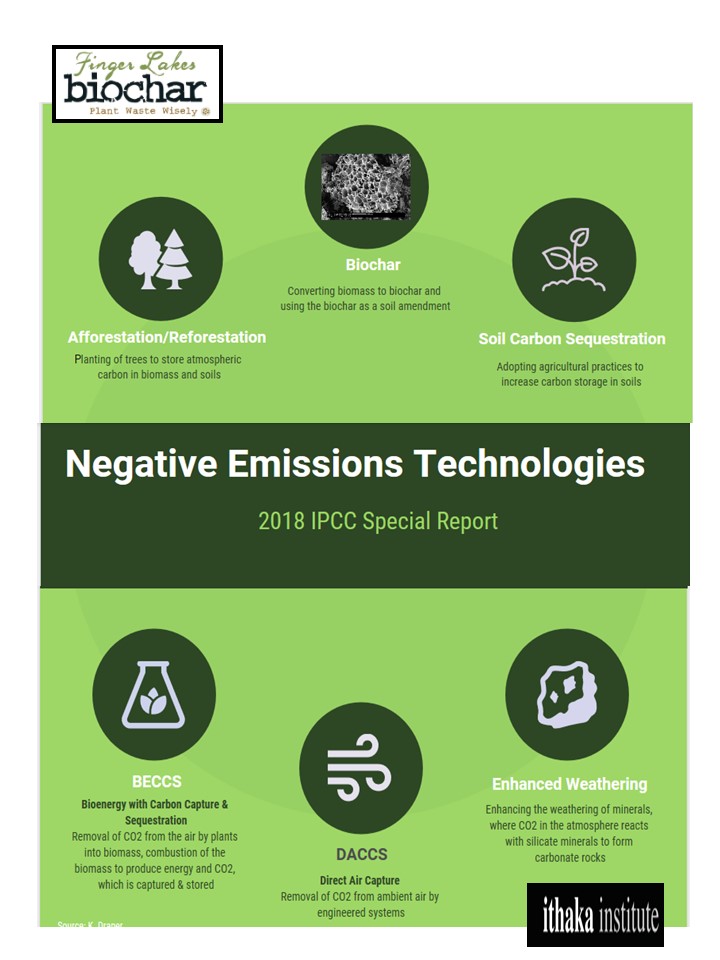Humanity is in need of a safety net to pull us back from the carbon brink. But what might this net, or more likely nets, look like? The recent IPCC report may provide some clues.
The IPCC’s recent Special Report state’s that while steep and rapid emission reductions are critical, we have come to a point where carbon must be pro-actively pulled out of the air and stored safely elsewhere. Storage options are limited to land or oceans (though no doubt some would like a moonshot!). Land-based storage options include soils, deep geological storage or rocks – yes rocks!
The report lists a mere six negative emissions technologies (NET) that they feel may be capable of drawing down massive amounts of carbon. Biochar, for the first time is included in that shortlist. To recap the sequestration mechanism offered by biochar: carbonizing underutilized organic material, be it sewage sludge, city green waste, storm debris, invasive species, food waste or myriad other sources, converts recently photosynthesized atmospheric carbon into stable, long-lasting carbon that can be stored in soils or safely incorporated into man-made materials.

Biochar, along with only two other NETs, afforestation/reforestation and soil carbon sequestration are ancient, proven processes which provide many other benefits beyond sequestration. The other three NETs; Bioenergy with Carbon Capture & Storage (BECCS), Direct Air Capture with Carbon Storage (DACCS), and Enhanced Weathering, have yet to be proven scalable, and may come with unintended consequences and enormous cost.
A limiting factor for many of the proposed NETs is land. There is only so much bare land that can effectively be converted to forests, agricultural land that can store carbon without endangering food production or biodiversity, or remote lands that can safely store carbon captured from bioenergy production smoke stakes or pulled from thin air.
While the IPCC’s report lists soil (presumably agricultural) as biochar’s storage medium, this is not entirely accurate. Much of the earlier biochar research focused on agricultural uses in soils, but increasingly it is being shown that biochar can be put to good use in urban soils for storm water management and in contaminated soils (e.g. mine lands, brown fields, landfills etc.) thereby expanding the amount of land where biochar can be sequestered. Also, it is important to note, that biochar is increasingly being eyed as a material to put into various man-made materials as a means of displacing non-renewable, expensive or high carbon footprint materials. These products have productive lives above the soil before finding their way into the soil. This includes many shorter-lived products such as kitty litter, bio-plastics or filtration carbon which may end up in landfills where it still sequesters carbon and may even reduce methane emissions. Longer-lived biochar-based products are gaining attention in the form of building materials which not only serve as carbon sinks but can provide insulation for housing and other environmental benefits.
One other thing to note with biochar is that it can increase the sequestration potential of both afforestation/reforestation and soil carbon sequestration. When used to plant trees, biochar can not only speed up growth, but it has been shown to provide increased resistance against disease pressure, so trees may live longer. While developing healthy forests, thinning is a must, and this provides the fodder for biochar which can then be put back into forest soils helping to further boost soil fertility and water management while sequestering more carbon.
Soil carbon sequestration includes changing destructive agricultural practices such as tilling and also the incorporation of organic material into soils. Combining biochar with other relatively short-term carbon materials (e.g. manure, crop residue, compost, etc.) can not only provide longer-term carbon sequestration, it can help hold onto nutrients longer which reduces other negative environmental impacts such as groundwater contamination or eutrophication.
So as the need for carbon safety nets grows and our window of opportunity shrinks, let’s make sure we chose NETs that are in fact safe, sustainable and offer a high possibility of success. For a more in depth perspective of this topic, please have a read of this article on the Biochar Journal.

